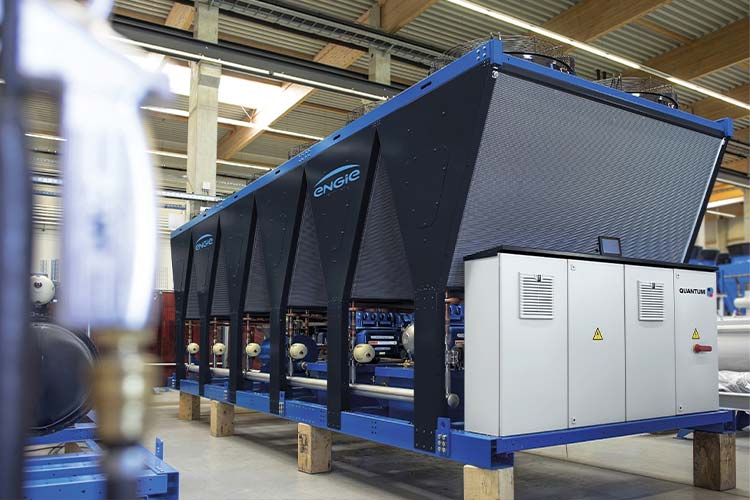

How do you cool an entire building, community, or even a City at the same time keeping the CO2 emissions at bay? In this special report, Yvon Mompeyssin, Head of Strategic Development for ENGIE Solutions, addresses this challenge
October 18, 2022 |
Warning: Trying to access array offset on value of type null in /home4/remtizmq/public_html/config/setting.php on line 28
| UAE |
Facilities Management

With the world continuing to urbanise at a frantic pace, the global demand for heating and cooling in urban environments will continue to increase. According to a report in Bloomberg, the demand for district cooling networks is expected to increase by 200% between 2016 and 2050.
The question arises, how do you cool an entire building, community, or even a City at the same time keeping the CO2 emissions at bay? That is a challenge that many District Cooling Services addresses.
A market leader in district cooling services through its equity stake in Tabreed, ENGIE Solutions is the world's largest independent provider of urban cooling networks. In this special report, Yvon Mompeyssin, Head of Strategic Development for ENGIE Solutions, gives REM Times an insight into the many solutions they provide to communities in the Middle East to address the challenges in district cooling.
ENGIE operates 320 projects worldwide in large campuses, communities, and even entire cities. A market leader for three decades, the Group continues to expand its presence in the Middle East, Asia, and North America.
In the region, ENGIE Solutions' Cooling-as-a-Service (CaaS) enables communities to benefit from a clean and energy-efficient cooling solution with no CAPEX spending. Customers simply pay for the cooling they use and asset availability, typically through monthly payments. With that, the incentive is on the energy service provider to design, finance, and install the most energy-efficient cooling solution. The motivation would also include the end users to efficiently consume the cooling energy provided as they will have to pay for consumption.
Reducing carbon footprint
Cooling networks such as those enabled by CaaS models significantly reduce greenhouse gases and accelerate the transition to carbon neutrality, in line with the region's national efficiency and sustainability targets. With cooling demand in the GCC expected to nearly triple by 2030, CaaS offers a modern, efficient way to provide air conditioning to a network of buildings in cities or campuses.
According to a report evaluating the impact of energy efficiency building codes for residential buildings in the GCC, air conditioning accounts for over 60% of total energy consumption in the region. Without action to address energy efficiency, global energy demand for space cooling will more than triple by 2050 – consuming as much electricity as all of China and India today. By aggregating the cooling need of a network of buildings, CaaS creates an economy of scale that drives efficiency, balances electric loads, and reduces fuel costs. “The CaaS model is also emerging as an integral part of smart city initiatives that are powering the growth of sustainable data-driven urban centers in the region. Data shows that efficient cooling solutions delivered by ENGIE Solutions enable 20 to 50% savings in energy compared to traditional chillers, leading to a considerable reduction in carbon emissions,” says Yvon Mompeyssin.
Measures taken to cool an entire neighborhood and reduce its CO2 emissions
Addressing this challenge, Yvon Mompeyssin says that ENGIE’s preferred measure is the implementation of a cooling network. “A cooling network is a centralized system that provides chilled water to supply an air conditioning system. The network includes chilled water production and distribution facilities to offer cooling services to all connected buildings. Operating as a closed circuit, the cooling network consists of two pipelines: one supplying chilled water to users and the other returning the water to the production plants,” he adds.
Compared with a traditional air conditioning system, such a network consumes 35% less electricity, emits 50 % less CO2, and generates over 50% energy efficiency.
Prominent CaaS solutions
ENGIE Solutions offers a 360-degree CaaS solution. “We start with design, where we work with the customer on a concept design, including reviewing the heat load calculations and the occupancy of the premises. Based on these two, we then decide on the optimum diversity factor, which accounts for further reduction in the carbon footprint. We also use our expertise to help select the most viable and efficient equipment and technology at this stage,” says Yvon Mompeyssin.
He goes on to explain how by using the Build on-Operate-Transfer (BOOT) model, they finance, design, construct, own, and operate the project before transferring it to the customer at the end of the contract period. “When the project is ready, we secure the supply and optimize the energy mix, including renewable and recovered energies. ENGIE Solutions is also responsible for operations and Maintenance (O&M) and the asset lifecycle cost throughout the contract period, providing risk-free operations to our clients,” adds Yvon Mompeyssin.